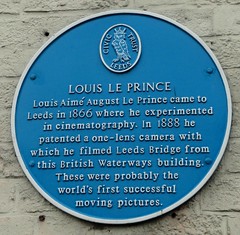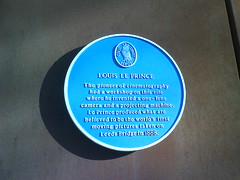Louis Le Prince
Commemorated on 2 plaques
Louis Le Prince. Louis Aime August Le Prince came to Leeds in 1866 where he experimented in cinematography. In 1888 he patented a one-lens camera with which he filmed Leeds Bridge from this British Waterways building. These were probably the world's first successful moving pictures.
adjacent to the Leeds Bridge, Leeds, United Kingdom where they made a film
Louis Le Prince The pioneer of cinematography had a workshop on this site where he invented a one-lens camera and a projecting machine. Le Prince produced what are believed to be the world's first moving pictures taken on Leeds Bridge in 1888.
Blenheim Terrace, Leeds, United Kingdom where they had a workshop



